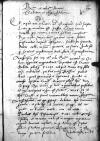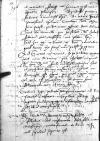Et apud nos in curia nihil est eiusmodi, quod scriptu lectuque iucundum esse posset, sunt tamen nonnulla, quae varie animos hominum versant.
⌊Rex noster senex⌋ nunc aegrotus iacet, solitis passionibus corporis affligitur scabie seu pruritu, dolore colli, manuum, pectoris et senio. Inde fit, quod hominum expeditiones tarde fiunt et procrastinatur.
⌊Archiepiscopum⌋ scit iam Dominatio Vestra Reverendissima mortuum ex carbone ingentis magnitudinis. Sepultus est ⌊Cracoviae⌋. Debita plus quam 50000 reliquit. Nemo ⌊eum⌋ flet, nisi creditores, quibus numquam satisfieri poterit. ⌊Huic⌋, quod speramus et optamus, succedet in episcopatum Cracoviensem dominus ⌊Plocensis episcopus⌋. Nam id quoque ⌊rex iunior⌋ per litteras a ⌊parentibus⌋ postulat, et ⌊rex antiquus⌋ in hac est sententia, ut ⌊is⌋ sit et episcopus Cracoviensis, et simul vicecancellarii munere fungatur.
Archiepiscopatus, uti ego persensi, dabitur ⌊episcopo Cuiaviensi⌋, homini et sibi ipsi, et amicis, et regi, et rei publicae, rei ecclesiasticae inutili, caeco et muto. ⌊Paulus episcopus Posnaniensis⌋ et non ambit archiepiscopatum, et revera non est in magna reputatione apud dominos nostros, eo quod esse saeptus filiis, filiabus, generis, consanguineis et est tenax, parcus, sordidus. ⌊Zebridowski⌋ ambit et mercatur fortasse, ut homines existimant, episcopatum Plocensem. ⌊Dziaduski⌋ putatur futurus Cuiaviensis episcopus. De ceteris episcopatibus Premisliensi, Chelmiensi, Camenecensi nihil adhuc sciri potest, quibusnam personis dari debeant. Sunt etiam nonnulli, qui existiment dominum ⌊Sobocz[ki]⌋ futurum aut archiepiscopum, aut Plocensem episcopum. Sed hoc agi videmus, ut ecclesia evertatur, quod tamen ⌊rex senex⌋ non potest perspicere. Ad sacras, ut vocant, exportabitur magna vis auri ⌊Romam⌋ pro chartis aliquot. Dominatio Vestra Reverendissima facile intelligit ascensus istos et ambitus episcoporum nostrorum noxios ac damnosos esse ⌊Regno⌋. Per quos ⌊Regnum⌋ maxim[a] vi auri est exhaustum et tamen huic detrimento non obviam itur.
⌊Comitia Regni⌋ indicta sunt hic ⌊Cracoviae⌋ ad 1545-11-25⌊diem Sanctae Catherinae1545-11-25⌋. Sperant plerique, quod negotia publica rectius constituentur subla[to] hoc obice ⌊archiepiscopo⌋.
⌊Reginalis maiestas⌋ domina nostra est salva cum ⌊filiabus⌋, sed vehementer dolet, flet, maerere[t] ⌊archiepiscopum⌋, cuius funus a domo usque ad sepulcrum secuta est.
⌊Rex iuvenis⌋ salvus est et recte valens. Moleste fert praesentem statum male gubernati ⌊Regni⌋. De nuptiis an aliquid fiat, nihil audio.
Scriptum est ex ⌊Ungaria⌋ ⌊regem Ferdinandum⌋ per legatos pacem perpetuam practicare cum ⌊Thurco⌋ hac condicione, ut tota Hungaria adusque ⌊Posonium⌋ sit Turci, reliqua pars minutata ut sit regis Ferdinandi, sed credi non potest etc.
Me et servitutem meam commendo Reverendissimae Dominationi Vestrae. Quam felicissime valere ex animo cupio.



